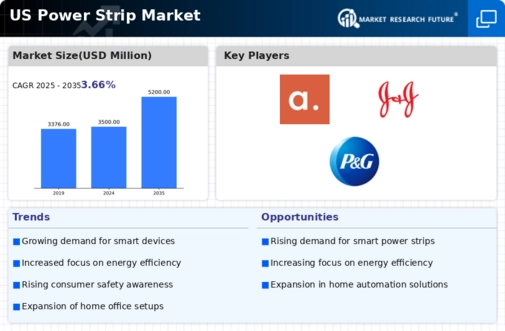Shift Towards Eco-Friendly Products
The power strip market is increasingly influenced by the shift towards eco-friendly products as consumers become more environmentally conscious. In 2025, it is projected that around 25% of consumers actively seek out sustainable power solutions. This trend is prompting manufacturers to explore materials that are recyclable and energy-efficient. Additionally, the demand for power strips that minimize energy consumption during standby mode is on the rise, as consumers aim to reduce their carbon footprint. The power strip market is thus adapting by offering eco-friendly options that align with consumer values, potentially leading to a competitive advantage in a market that is becoming more focused on sustainability.
Rising Awareness of Electrical Safety
The power strip market is significantly influenced by the growing awareness of electrical safety among consumers. With an increase in the number of electrical fires and accidents attributed to faulty power strips, there is a heightened demand for products that prioritize safety features. In 2025, it is estimated that nearly 40% of consumers consider safety features as a primary factor when purchasing power strips. This trend has prompted manufacturers to innovate by incorporating features such as overload protection, circuit breakers, and flame-resistant materials. Consequently, the power strip market is responding to these safety concerns by developing products that not only meet regulatory standards but also provide peace of mind to consumers.
Growing Demand for Home Office Solutions
The power strip market is experiencing a notable surge in demand due to the increasing prevalence of home office setups. As more individuals work remotely, the need for reliable power solutions has intensified. In 2025, it is estimated that approximately 30% of the workforce in the US is engaged in remote work, leading to a heightened requirement for power strips that can accommodate multiple devices. This trend is further supported by the rise in electronic devices per household, with an average of 10 devices requiring power. Consequently, the power strip market is adapting to meet these needs by offering products that provide enhanced functionality, such as USB ports and surge protection, ensuring that consumers have access to safe and efficient power solutions.
Expansion of E-Commerce and Online Retail
The power strip market is experiencing a transformation due to the expansion of e-commerce and online retail platforms. As consumers increasingly prefer the convenience of online shopping, the accessibility of power strips through various digital channels is enhancing market growth. In 2025, it is estimated that online sales of power strips will account for approximately 35% of total sales in the industry. This shift is encouraging manufacturers to optimize their online presence and engage in targeted marketing strategies to reach a broader audience. Consequently, the power strip market is likely to benefit from this trend, as consumers seek out competitive pricing and product variety available through online platforms.
Technological Advancements in Power Strip Design
The power strip market is witnessing significant innovation driven by advancements in technology. Manufacturers are increasingly integrating smart features into power strips, allowing users to control their devices remotely via smartphone applications. This trend is indicative of a broader shift towards smart home technology, which is projected to grow at a CAGR of 25% through 2026. Additionally, the incorporation of energy monitoring capabilities in power strips is becoming more prevalent, enabling consumers to track their energy usage and reduce costs. As a result, the power strip market is evolving to offer products that not only provide power but also enhance user experience and energy efficiency.














Leave a Comment